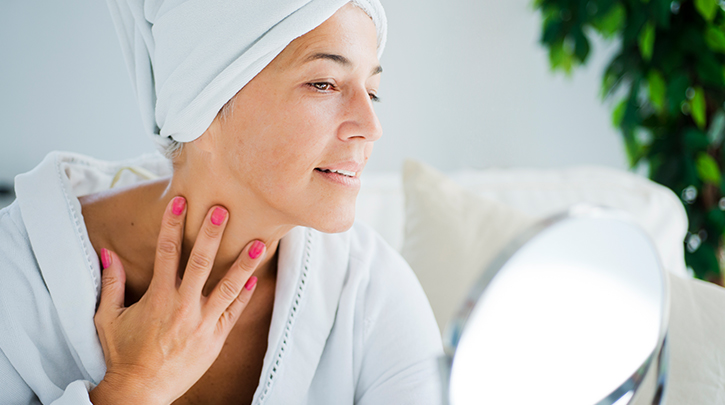
- Global
Get non-surgical solutions for today's top aesthetic concerns with Venus Treatments. Join thousands of satisfied patients worldwide!
- Loading...
- All Regions
Get non-surgical solutions for today's top aesthetic concerns with Venus Treatments. Join thousands of satisfied patients worldwide!

In the minds of many, glowing skin is a sign of a healthy, happy pregnancy. Unfortunately for a lot of women, a rosy, radiant complexion isn’t a given. Instead, many expecting mothers experience troubles with acne, dark spots, increased hair growth, a decrease in skin’s elasticity, melasma, and other changes in their skin during pregnancy. How might your skin change during pregnancy and how can you help balance out skin health? The following are some of the most common ways that pregnancy can alter skin health and how you might be able to reverse the effects.
According to top skin care experts, shifts in hormone levels, oil production, and an average 40% rise in blood volume may be credited for that gorgeous pregnancy glow. The increase in blood volume delivers more nutrients and oxygen to the skin, while weight gain can help fill out the face and make skin appear tighter and smoother. However, these changes, particularly the increase in oil production, may also be the root cause of acne breakouts. Hormone fluctuations as well as a boost in blood volume can kick oil production into high gear, leading to excess sebum and a higher likelihood that dead skin cells will stick to the skin’s surface and clog pores. Acne types may vary, but the cause remains similar for those experiencing hormonal acne during pregnancy.
While those who are pregnant or nursing are better off consulting a dermatologist for safe natural treatments for acne control, those who have given birth and are not breastfeeding may opt into an acne treatment plan that utilizes targeted Intense Pulsed Light (IPL) to fend off continued breakouts while the skin works to regain its balance. Utilizing red and blue light, IPL-based acne treatments target and destroy acne-causing bacteria while getting acne-related inflammation under control. This gives skin a better chance of not only reining in breakouts, but also properly healing to prevent potential acne scarring.
Known as the “mask of pregnancy,” melasma is a condition that about 50% of all pregnant women experience, though there are also other causes that may increase your risk of developing melasma. Appearing as dark brown patches on the face, melasma is linked to a rise in the hormones estrogen and progesterone, as well as a melanocyte-stimulating hormone that has a direct impact on skin tone (melanocyte cells or melanin are what give pigment to the skin). All three hormones reach their highest levels nearing the end of the pregnancy, in the final trimester. Melasma is also linked to excessive sun exposure, meaning it’s best to always wear SPF while pregnant and limit sun exposure as much as possible to prevent hyperpigmentation.
Post-pregnancy and following nursing, melasma and brown spots are likely to stick around. While some topical treatments might work to very gradually fade these spots, a customized IPL photofacial treatment may be the best option for a quicker outcome. These treatments target dark spots by breaking down melanin concentrations while stimulating skin’s natural healing cycle for clearer, more even-toned skin.
While thick, flowing tresses may seem like a benefit, pregnancy hormones don’t just increase hair growth on the head. Generally speaking, hair tends to grow for a period of two to six years before experiencing a short resting phase, then falling out. Hormone fluctuations during pregnancy can extend hair’s resting time between the growth and shedding stages, meaning thicker hair basically everywhere—the head, face, underarms, legs, arms, and even down there.
Following pregnancy, customized hair removal treatments can be of benefit to get hair growth back under control. While IPL and laser diode treatments are the top choices on the market, there are a variety of energy-based hair removal options to consider. Whatever the modality of choice, these treatments utilize energy that is transferred to heat and targeted at hair follicles in the growth or anagen phase, destroying the follicle and inhibiting future growth. The result is gorgeous, smooth skin alongside a permanent reduction in hair growth that may help a busy mom save a little extra time. Since some hair will fall out post-pregnancy as hormone levels start to return to normal, it might be best to let things settle before booking your first appointment.
One of the most commonly discussed skin changes following pregnancy, stretch marks occur as areas of the body rapidly gain weight and stretch to accommodate the growing baby. Affecting about 90% of pregnant women, stretch marks are a result of a tear in the middle layer of skin, called the dermis, following rapid stretching. When this happens, the collagen fibers that give skin its structure break and blood vessels become visible through the weakened skin, leading to the deep purple or pink color most often associated with stretch marks. As the skin attempts to patch up the tear, collagen and elastin fibers are laid haphazardly, leading to variations in texture. Stretch marks most often pop up on the bellies, thighs, buttocks, and breasts. While moisturizers and vitamin E may help support skin hydration, studies suggest the proof isn’t there to support their use as a proven preventative strategy against stretch marks, meaning that unfortunately, there’s no real way to lessen your risk of developing them.
For those wishing to reduce the appearance of stretch marks, it’s important to note that stretch marks cannot be fully removed but their appearance can certainly be diminished to the point that they are no longer noticeable. A successful treatment must support skin health in three ways:
One option that checks all the boxes is radio frequency-based skin resurfacing treatments. Safe and effective for all skin tones, these treatments utilize tiny pins to effectively deliver heat via radio frequency (RF) energy to the affected dermis, kickstarting the skin’s natural healing process. By stimulating an increase in the production of collagen and elastin fibers, these treatments repair signs of visible textural irregularities, resulting in smoother, healthier-looking skin.
Just as skin can find it difficult to adjust to rapid weight gain, it can also have troubles bouncing back after rapid weight loss. Estrogen and progesterone are not well known for supporting skin’s elasticity, so elastin production levels can struggle to keep up during and after pregnancy. Likewise, skin simply needs time to adjust with weight loss post-pregnancy. Losing more than one to two pounds per week could increase your chance of loose skin that lingers long after your baby is born.
To decrease your likelihood of experiencing loose skin on the stomach or elsewhere, aim to lose pregnancy weight gradually and consider pairing weight loss efforts with relaxing RF-based skin tightening treatments. Utilizing RF energy to deliver uniform heat below the skin’s surface, these treatments help kickstart elastin and collagen production for tighter, smoother skin. Plus, with treatments taking no longer than 30 minutes and feeling like a relaxing hot stone massage, a customized skin tightening treatment plan may just offer the short, energizing retreat you need to be your best self for your new family.
The body goes through a lot of changes when it’s growing a little one inside. While these changes and the life they create are beautiful, it’s understandable that each mother has her own idea of how she envisions herself following pregnancy. For some, stretch marks and loose skin may be a reminder of her strength. For others, they may know internally the ways they have grown and look to shape their body their own way. Whatever your personal choices may be, for those seeking aesthetic treatments, ensure you visit a trusted certified treatment provider for the best treatment outcome and know that for some treatments, if you are nursing, you may need to wait until you’re done to begin your customized treatment plan.
We know you’re strapped for time, so we’re here to make finding a certified treatment provider near you just a little easier. Simply use the search field below to get started
Find a certified Venus Treatments provider near you today who specializes in today’s top aesthetic medical solutions.



Search below to find a provider near you and to learn about our non-surgical aesthetic treatments with ARTAS®, NeoGraft®, Venus Bliss™, Venus Blilss MAX™, Venus Versa™, Venus Legacy™ Venus Versa™ Pro, Venus Velocity™, Venus Viva™ MD, and Venus Glow™.
For more information call: (888) 907-0115 // [email protected] // 235 Yorkland Blvd., Suite 900, Toronto, ON, M2J 4Y8 Canada
REGULATORY CLEARANCES [ More ]
Venus Bliss™ is cleared by the FDA and licensed by Health Canada for non-invasive lipolysis of the abdomen and flanks in individuals with a Body Mass Index (BMI) of 30 or less, with the diode laser applicators. The (MP)2 applicator is cleared by the FDA for temporary reduction in the appearance of cellulite, and licensed by Health Canada for temporary increase of skin tightening, temporary circumferential reduction, and temporary cellulite reduction. Venus Bliss™ has CE Mark as a non-invasive medical aesthetic device enabling a comprehensive approach leading to body contouring, addressing fat reduction, skin tightening, circumference reduction, and cellulite reduction.
Venus Versa™ is cleared by the FDA, licensed by Health Canada, and has CE Mark as a multi-application device intended to be used in aesthetic and cosmetic procedures. The SR515 and SR580 applicators are cleared by the FDA, licensed by Health Canada, and have CE Mark for the treatment of benign pigmented epidermal and cutaneous lesions and treatment of benign cutaneous vascular lesions. The HR650/HR650XL and HR690/HR690XL applicators are cleared by the FDA, licensed by Health Canada, and have CE Mark for the removal of unwanted hair and to effect stable long-term or permanent hair reduction for Fitzpatrick skin types I-IV. The AC Dual applicator is cleared by the FDA, licensed by Health Canada, and has CE Mark for the treatment of acne vulgaris. The DiamondPolar™ and OctiPolar™ applicators on the Venus Versa™ system are cleared by the FDA for non-invasive treatment of moderate to severe facial wrinkles and rhytides on females with Fitzpatrick skin types I-IV. The DiamondPolar™ applicator is licensed by Health Canada and has CE Mark for non-invasive treatment of moderate to severe facial wrinkles and rhytides on females with Fitzpatrick skin types I-IV. The OctiPolar™ applicator on the Venus Versa™ system is licensed by Health Canada and has CE Mark for temporary body contouring via skin tightening, circumferential reduction, and cellulite reduction. The NanoFractional RF™ (Viva) applicator is cleared by the FDA, licensed by Health Canada, and has CE Mark for dermatological procedures requiring ablation and resurfacing of the skin.
NeoGraft® is cleared by the FDA, licensed by Health Canada and has CE Mark with indication for use in suction-assisted follicular extraction and re-implantation. It is an auto-graft system and can be used on both male and female patients.
ARTAS iX™ is cleared by the FDA, licensed by Health Canada and has CE Mark with indication for use for harvesting hair follicles from the scalp in men diagnosed with androgenic alopecia (male pattern hair loss) who have black or brown straight hair. ARTAS iX™ is intended to assist physicians in identifying and extracting hair follicular units from the scalp during hair transplantation; creating recipient sites; and implanting harvested hair follicles.
Venus Legacy™ is cleared by the FDA for the non-invasive treatment of moderate to severe facial wrinkles and rhytides in females with Fitzpatrick skin types I-IV with the OctiPolar™ and DiamondPolar™ applicators, and temporary reduction in the appearance of cellulite with the 4D Body (LB2) and 4D Face (LF2) applicators. It is licensed by Health Canada and has CE Mark for the temporary increase of skin tightening, temporary circumferential reduction, temporary cellulite reduction, and temporary wrinkle reduction.
Venus Velocity™ is cleared by the FDA, licensed by Health Canada and has CE Mark for hair removal, permanent hair reduction (defined as the long-term stable reduction in the number of hairs re-growing when measured at 6, 9 and 12 months after the completion of a treatment regimen), and the treatment of pseudofolliculitis barbae for all Fitzpatrick skin types.
Venus Fiore™ received regulatory approval in Israel for aesthetic and functional treatment of the vagina, labia and mons pubis. Venus Fiore™ is available for sale in India, Hong Kong, and other selected Asian countries.
Venus Viva™ is cleared by the FDA, licensed by Health Canada, and has CE Mark for dermatological procedures requiring ablation and resurfacing of the skin. The DiamondPolar™ applicator is cleared by the FDA, licensed by Health Canada and has CE Mark for the treatment of moderate to severe wrinkles and rhytides in Fitzpatrick skin types I-IV.
Venus Freeze Plus™ is cleared by the FDA for the non-invasive treatment of moderate to severe facial wrinkles and rhytides in females with Fitzpatrick skin types I-IV. It is licensed by Health Canada for temporary skin tightening, and temporary reduction in the appearance of cellulite on the abdomen and flanks, using the DiamondPolar™ and OctiPolar™ applicators. The DiamondPolar™ applicator on Venus Freeze Plus™ has CE Mark for the non-invasive treatment of moderate to severe facial wrinkles and rhytides, and the increase of skin tightening, temporary circumferential reduction, and cellulite reduction with the OctiPolar™ applicator.
Venus Heal™ is licensed by Health Canada and can be used for the treatment of both acute and chronic disorders of the musculoskeletal system, such as muscle spasms, back pain, and soft tissue injuries, and results in effects such as pain relief, myorelaxation, increase of local blood circulation, and edema reduction. In the U.S., Venus Heal™ is cleared by the FDA for the relief of minor muscle aches and pain, relief of muscle spasm, and temporary improvement of local blood circulation. These indications enable the treatment of certain soft tissue injuries and conditions.
Venus Glow™ is cleared by the FDA as a Class I motorized dermabrasion device. It provides a dermal rejuvenation treatment that works to open up and deep-clean pores. Venus Concept is the exclusive distributor for Venus Glow™.
Venus Epileve™ is licensed by Health Canada and has CE Mark for hair removal, permanent hair reduction (defined as the long-term stable reduction in the number of hairs re-growing when measured at 6, 9 and 12 months after the completion of a treatment regimen), and the treatment of pseudofolliculitis barbae for all Fitzpatrick skin types. Venus Epileve™ is also CE-Marked for hirsutism.
Venus Freeze™ is cleared by the FDA for the non-invasive treatment of moderate to severe facial wrinkles and rhytides in females with Fitzpatrick skin types I-IV. It is licensed by Health Canada for temporary skin tightening, and temporary reduction in the appearance of cellulite on the abdomen and flanks, using the DiamondPolar™ and OctiPolar™ applicators. The DiamondPolar™ applicator on Venus Freeze™ has CE Mark for the non-invasive treatment of moderate to severe facial wrinkles and rhytides, and the increase of skin tightening, temporary circumferential reduction, and cellulite reduction with the OctiPolar™ applicator.
Venus Swan™ is cleared by the FDA for the non-invasive treatment of moderate to severe facial wrinkles and rhytides, and licensed by Health Canada for the non-invasive treatment of cellulite reduction, skin tightening, and temporary reduction in the appearance of stretch marks.
Copyright © 2025 Venus Concept. All rights reserved.
You are entering our website. For other countries/regions and language options, please click the SELECT A DIFFERENT REGION button below.
SELECT A DIFFERENT REGIONAre you looking to get a treatment? Please visit our patient website to learn more.
Click HereUnsure which aesthetic treatment is right for you? Take this quick and easy quiz to discover treatments that suit your needs.
Get Started